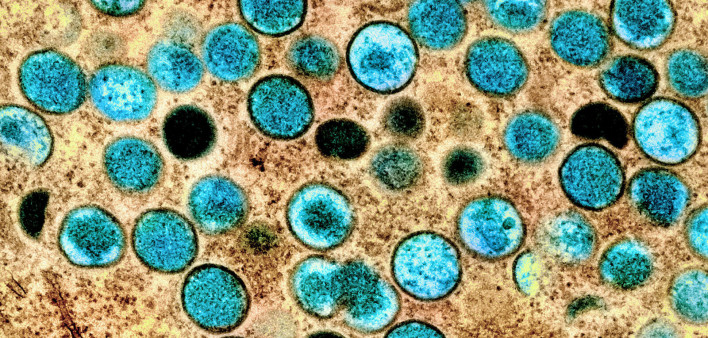The monkeypox virus spreads through close personal contact and “is not transmitted during short periods of shared airspace,” the Centers for Disease Control and Prevention (CDC) said in a media statement last week.
The clarification came after a June 7 New York Times article entitled “Monkeypox Can Be Airborne, Too,” which suggested that the virus can be “transmitted through aerosols, similar to the coronavirus” that causes COVID-19.
Unlike COVID, monkeypox is not a new disease. It has been circulating for decades in Central and West Africa, and it is known to be transmitted primarily from animals (especially rodents) and through close person-to-person contact.
The current monkeypox outbreak in countries where the virus is not endemic mostly involves gay, bisexual and other men who have sex with men. Although it is not yet clear whether the virus is sexually transmitted in semen during intercourse, it can spread through skin-to-skin contact that happens during sex.
As of June 15, the CDC has reported 84 confirmed cases of monkeypox in 18 states and Washington, DC. Worldwide, the World Health Organization (WHO) has confirmed 1,285 cases in more than two dozen non-endemic countries as of June 10, as well as 1,536 suspected cases in Africa.
Known Transmission Routes
The monkeypox virus is transmitted through close personal contact, which can include skin-to-skin contact, kissing and contact with contaminated clothes, bedding or towels. It also can be transmitted via respiratory droplets at close range, but it does not spread over longer distances like the SARS-CoV-2 coronavirus. Experts think transmission happens mainly—or perhaps only—when people are symptomatic.
“Monkeypox virus is a completely different virus than the viruses that cause COVID-19 or measles. It is not known to linger in the air and is not transmitted during short periods of shared airspace,” the CDC stated. “Monkeypox spreads through direct contact with body fluids or sores on the body of someone who has monkeypox, or with direct contact with materials that have touched body fluids or sores, such as clothing or linens. It may also spread through respiratory secretions when people have close, face-to-face contact.”
The agency added that prior studies of monkeypox outbreaks show that the spread of monkeypox virus via respiratory secretions appears to be uncommon.
“While we do not know with certainty what role direct physical contact has versus the role of respiratory secretions, in instances where people who have monkeypox have travelled on airplanes, no known cases of monkeypox occurred in people seated around them, even on long international flights,” the statement reads.
Giving some examples, the agency said monkeypox can be transmitted between people who live in the same household or share a bed and through the kind of face-to-face interactions that happen when someone lives with or cares for a person who has the virus. It is not thought to be transmitted via casual conversation, passing someone in a grocery store or touching items like doorknobs.
Combatting Confusion
Since the global outbreak was first reported in the United Kingdom in early May, there has been much speculation in the press and on social media that monkeypox is airborne in a manner similar to SARS-CoV-2, accompanied by calls for universal mask use.
Rapidly changing messages from the CDC have not helped the situation. In response to the ongoing outbreak, the agency updated its travel advisory for monkeypox in early June, upgrading it from Level 1 (“practice usual precautions) to Level 2 (“practice enhanced precautions”). The advisory recommended regular hand washing and wearing a face mask to protect against monkeypox and other diseases. But the agency removed the mask recommendation a few days later, saying it caused confusion.
The CDC continues to recommend that people diagnosed with monkeypox wear a high-quality mask “if they must be around others in their homes if close, face-to-face contact is likely.” Well-fitted masks are also recommended for health care workers and others caring for patients with monkeypox.
Shifting messages and confusion about the meaning of “respiratory,” “aerosol” and “airborne” transmission hampered the early response to COVID-19. Initially, the coronavirus was thought to be transmitted only in respiratory droplets at close range, but it later became clear that it could linger in the air and spread over longer distances.
“There are important differences between airborne transmission and transmission via respiratory secretions,” the CDC clarified in its statement. “Airborne transmission occurs when small virus particles become suspended in the air and can stay there for periods of time. These particles can spread on air currents, or sometimes even infect people who enter a room after the infected person has left. In contrast, monkeypox may be found in droplets like saliva or respiratory secretions that drop out of the air quickly.”
Close-range respiratory transmission could occur when people have monkeypox sores in their mouth or throat, according to Capt. Jennifer McQuiston, DVM, deputy director of the CDC’s Division of High Consequence Pathogens and Pathology.
The New York Times article noted that smallpox, which is related to monkeypox but more severe, reportedly spread via airborne transmission in some cases. And during a 2017 monkeypox outbreak in Nigeria, prisoners and health care workers who did not have direct contact with patients became infected. A recent monkeypox situation summary from WHO suggests that transmission via “short-range aerosols” is a possibility.
But the CDC maintains that airborne transmission of monkeypox is unlikely and has not been reported to date.
“What we do know is that those diagnosed with monkeypox in this current outbreak described close, sustained physical contact with other people who were infected with the virus,” CDC director Rochelle Walensky, MD, MPH, told reporters during a June 10 media briefing. “This is consistent with what we’ve seen in prior outbreaks and what we know from decades of studying this virus and closely related viruses.”
Click here to learn more about monkeypox.







Comments
Comments